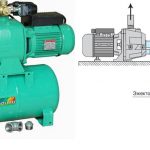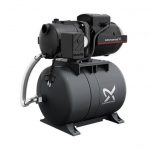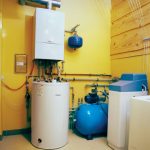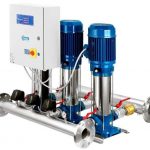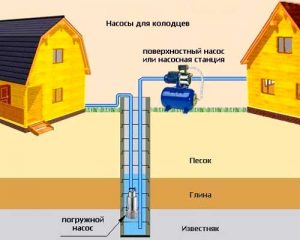 Quite often, owners of private buildings have problems with constantly supplying water to their personal plot, drilling a well or digging a well does not solve it - it is necessary to install a unit that will lift water from the well and create optimal pressure in the pipe system to move it to any point. For such purposes, a pumping station or a submersible pump lowered into a water mirror is ideal.
Quite often, owners of private buildings have problems with constantly supplying water to their personal plot, drilling a well or digging a well does not solve it - it is necessary to install a unit that will lift water from the well and create optimal pressure in the pipe system to move it to any point. For such purposes, a pumping station or a submersible pump lowered into a water mirror is ideal.
Among the users there are few people who are well versed in such equipment in order to eliminate gaps in your horizons, we suggest that you carefully read our article, where you can find answers to many questions that interest you and solve the problems that arise with providing clean water for your home at any time.
Content
What is the difference between devices
Distinctive features of pumping stations for a summer house or a country house are their unique compactness, quick installation, as well as simple maintenance and affordable cost for all segments of the population. The water tank accumulates in the hydraulic tank, which allows the product to turn on and off less often - as a result, its service life is increased.
The pump is installed inside the hydraulic structure under water, and the pump station for the well is mounted in the basement of the house or in a specially constructed caisson, which is insulated during cold weather.
Features, pros and cons of each
A pumping station for a well or a well is a specific technique consisting of several very important details and components:
- hydraulic accumulator;
- pump;
- a relay that controls the on and off of the pump;
- system for filtering water from impurities;
- safety valve;
- pipes for water supply or their soft analogues.
More expensive models are additionally equipped with functions of protection against overheating and work without water.
The submersible pump was designed for installation under water inside a well. In order for the equipment to work effectively, it is very important to provide effective protection when the groundwater level drops sharply. Therefore, experts in the operation of similar equipment are advised to use a system such as a float, which opens the electrical circuit when the water level drops sharply.
Advantages and disadvantages of stations
The benefits include:
- small sizes of the hydraulic accumulator;
- easy installation and disassembly if necessary;
- affordable maintenance and repair work;
- democratic value.
Like any technique, they have specific negative qualities:
- when installed inside the building or in the immediate vicinity, it makes a lot of noise, so its installation is associated with significant costs for sound insulation;
- high consumption of electric energy;
- it is necessary to insulate for the winter and provide constant ventilation of the room where the equipment is located;
- to take water from a depth of more than 8 m, you need to install an ejector;
- the electric motor is cooled only by the pumped liquid, so it can turn off - the overheating protection system is activated;
- sometimes the pump can give low efficiency, and the use of a more powerful unit will lead to an excessive consumption of electric energy;
- short term of operation;
- use of an additional filter system, because the performance depends on the purity of the water.
Compared to submersible pumps, stations have lower productivity, even with pressure stabilization.
Pros and cons of pumps
First, consider the positive qualities:
- silent operation, because the engine is under water;
- can lift water from great depths up to 40 m;
- compact size of the product allows you to install it in the well
- very high work efficiency;
- high reliability and long service life;
- it is possible to select products based on water pressure;
- its location inside the well allows you to save space not only in the house, but also on the territory of the infield;
- when preserving for the winter period, it is necessary to remove it from the water to the surface, drain the water and close the suction port.
Disadvantages:
- each opening of the taps in the house, for example, in order to wash hands before eating, to draw water into the kettle, causes the pump to start, and each product is designed for a certain number of such cycles;
- the complexity of preventive maintenance, because the units are mounted inside the well, each time it must be raised to the surface for inspection and maintenance;
- pretty high cost. maintenance and repair.
For deep wells, it is recommended to install submersible centrifugal pumps to prevent damage to the filtration system and the inner walls of the well.
Optimal selection criteria
Choosing pumping equipment is not as easy as it seems at first glance, because it is necessary to take into account personal wishes, the availability of free cash, as well as the following factors:
- Dimensions of the future hydraulic structure.
- The required minimum fluid intake, for example, during the day. This parameter is easy to calculate, given the presence of permanently residing family members, as well as household appliances: for example, a washing machine, shower, bathtub, toilet bowl, which are constantly operated in the house.
- Dynamic level - it must be correctly determined; for this, water is pumped out, and the level at which the liquid ceases to decrease is considered dynamic. If within 40 minutes of pumping, the thickness of the water layer changes slightly, then this well has a good debit and it is impossible to completely pump out water from it.
- Static level - determined by measuring the distance from the soil surface to the water level, the equipment should be completely turned off. It is advisable to make a measurement after prolonged non-use of the pump in order to find out the real completeness of filling the well.
- The remoteness of the water source. To do this, measure the distance from the house to the well, then add the height of the location of the most distant point of water intake.
- The concentration of impurities in the liquid so that expensive equipment does not break during the first days of operation.
Experts advise choosing equipment based on the depth of groundwater:
- Up to 8 meters - use a surface pump or pump station.
- 8-21 m - pumps with ejectors.
- 10-81 m - submersible pumping devices.
- Deeper than 81 m - only deep-well pumping units of high power.
Before installing the equipment it is necessary to make very accurate measurements.
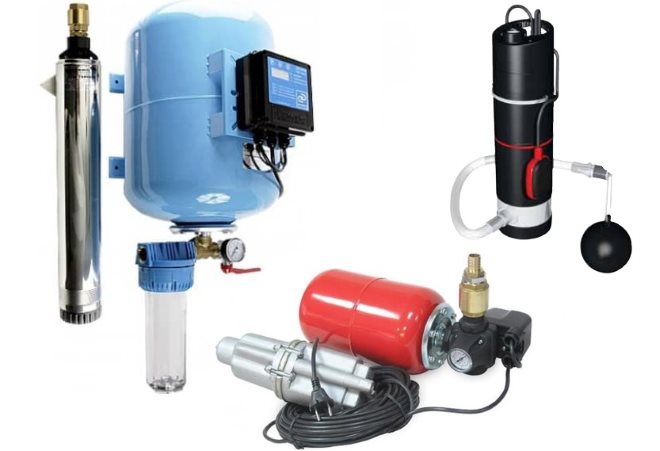
Surface pump
It is located on the surface, and when the well is very deep, then inside the structure, because the optimal height of the normal rise of water is within 6-8 m, a maximum of not more than 10 meters. An ejector is used to increase this indicator, but it can reduce the efficiency and reliability of the entire system.
Similar pumps can perfectly cope with the tasks with a shallow depth of water, while a high-quality automation system and hydraulic accumulator increase its service life.
Submersible pump
It sinks into the water below the mirror and perfectly pumps water from a fairly large depth, it is much more effective than a surface product.The case at the unit is sealed, it is made of stainless, very strong steel or polymers resistant to moisture. When compiling, a balance must be struck between such basic parameters as power and performance.
The depth of immersion is also taken into account, while an important parameter is the suction cone, which is created due to the strong traction of the product. Check the quality of the filter element and the automation protection. So that the unit does not draw in sludge or sand during operation, it is lowered no lower than a meter from the bottom. You can protect the product with a suspended circle from a material that does not accept corrosion - it is located 15 cm above the bottom, and its diameter is made smaller than the width of the hydraulic structure. The flow of water will move along the walls of the well, because the suction cone will abut against the circle.
In wells with a deep occurrence of groundwater, borehole pumps are installed that are not afraid of impurities in the water: for example, ESPA Neptun —185 g / cu. m or Water cannon of the Moscow company Dzhileks - up to 300 g / cu. m
Which pump to choose
The basis is the depth at which the most effective work takes place: if it is large, then a submersible unit is needed, and when the level is small, then a surface device will do, it is much smaller and lighter, therefore it can easily be moved to the right place.
The efficiency of deep-seated products is greater, because a surface-type pump spends energy on creating a vacuum of air to ensure liquid absorption. The fit and material of all the details of the immersed product is very high, because the slightest penetration of water will lead to the failure of the product, and leakage of technical oil will contaminate the liquid, cleaning will be very expensive.
It is necessary to choose pumping equipment with great responsibility and caution, buying a low-power model with low build quality can result in high financial costs: if an improper operation results in an unexpected bottom rise, a sharp decrease in the water level or its pollution with oil, then you will have to call specialists to solve these problems.
findings
To provide wells or boreholes with a shallow depth of up to 10 meters, pumping stations of a compact type can be used, providing daily normal water supply for the user's needs. In order to provide high-quality water supply to a private building from a well with a depth of more than 12 m, only submersible pumps will have to be used.

